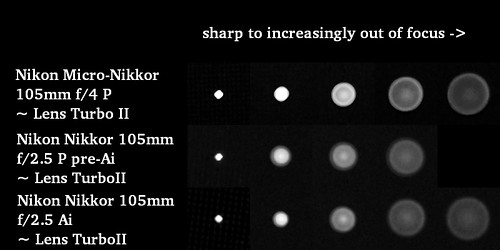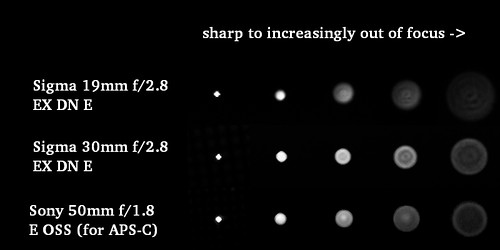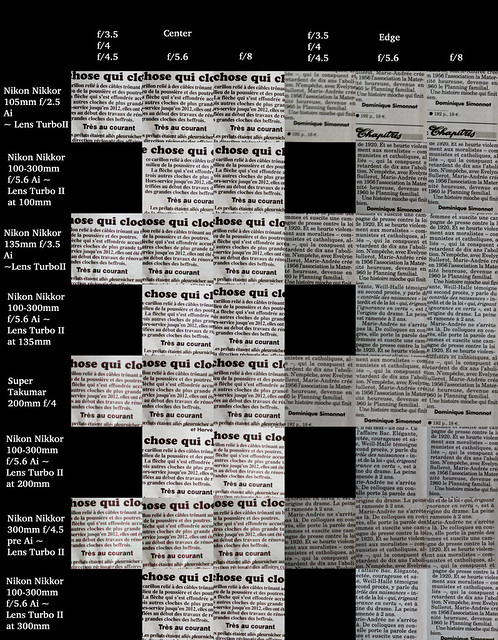For many years I looked at just one dimension of commercially available optics - resolution. Now I continue to look at other aspects of optical performance. For this series I look at under, neutral, and over corrected spherical aberration in out of focus rendition on subject matter behind the point of focus.
Setup -
- Sony NEX5T, ISO 100, 2 second timer, +1 EV
- Big Beefy Manfrotto tripod
- Lenses using with a Lens Turbo II focal reducer -
- Nikon Micro-Nikkor 105mm f/4 Ai
- Nikon Nikkor 105mm f/2.5 P pre-Ai (early Sonnar design)
- Nikon Nikkor 105mm f/2.5 Ai (later modified Sonnar, slightly more symmetrical design)
- NOTE1: Lenses were shot at their widest apertures only
- NOTE2: Out of focus samples are from points _behind_ the point of focus to compare background out of focus rendition
- RawTherapee to convert RAW files into black and white and to set the black levels
If you click on the following image you can inspect it at 100 percent.

Comments -
NOTE: I feel the Lens Turbo II focal reducer adds a bit of under-corrected spherical aberration.
I had expected the Micro-Nikkor to show similar neutral very smooth out of focus rendition to the pair of 55mm Micro-Nikkors I looked at. Alas, this is not the case.
These three Nikon Nikkor, Micro-Nikkor 105mm f/4 and f/2.5 P pre-Ai and Ai lenses show under corrected spherical aberrations. At the point of focus, the Micro-Nikkor is one of the sharpest lenses I've looked at. But that's not what this comparison is about.
In normal photography I would expect, based on these comparisons, that there will be a very smooth and delicate (to use Nikon's own word on the topic) out of focus field rendition, with the f/4 Micro-Nikkor showing a stronger "condom ring" (which will contribute to a distracting out of focus rendition) than the two f/2.5 lenses (compare the smooth, rounded edges of the out of focus disks of the f/2.5 lenses against the sharp edged disks of the Micro-Nikkor).
Resources -
For further information on how the topic of out of focus rendition, optical properties, and Nikon lens design history, please refer to the following -
A PhD thesis on the impact of "soft focus" lenses on the history of photography - http://research-repository.st-andrews.ac.uk/handle/10023/505
An excellent starting point for understanding out of focus rendition (I might not completely agree with his interpretations/observations, but his foundation of understanding is quite good) - http://jtra.cz/stuff/essays/bokeh/
Nikon lens design histories - https://imaging.nikon.com/history/story/
Point light source discussions - https://www.dpreview.com/forums/thread/4031515
Zeiss comments on optical design - https://lenspire.zeiss.com/photo/en/article/how-does-zeiss-define-bokeh-an-interview-with-dr-stefan-ballmann
Metabones Focal Reducer whitepaper - https://www.metabones.com/assets/a/stories/Speed%20Booster%20White%20Paper.pdf



